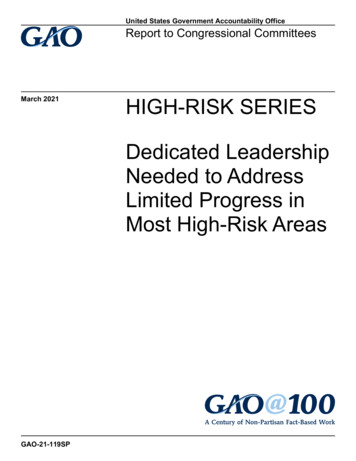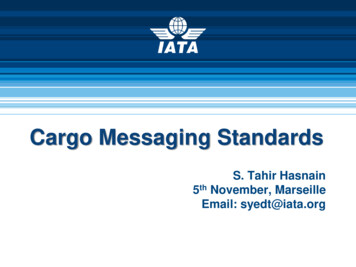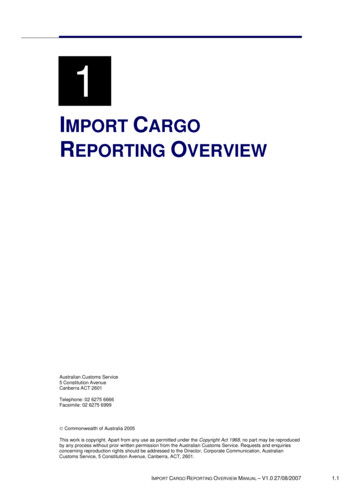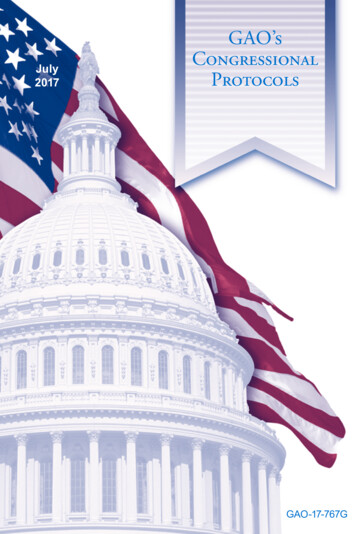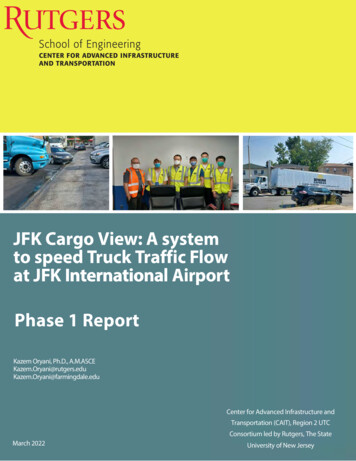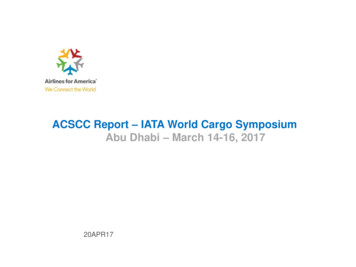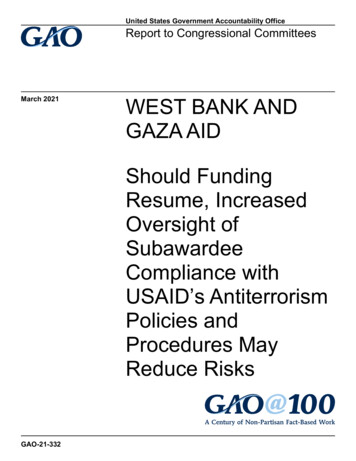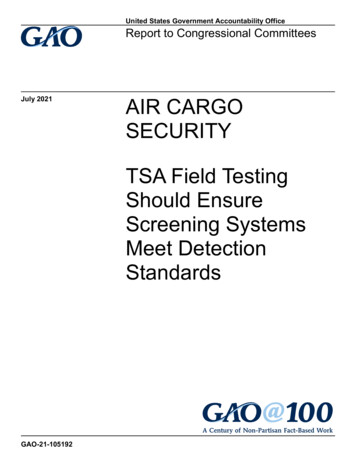
Transcription
United States Government Accountability OfficeReport to Congressional CommitteesJuly 2021AIR CARGOSECURITYTSA Field TestingShould EnsureScreening SystemsMeet DetectionStandardsGAO-21-105192
July 2021AIR CARGO SECURITYTSA Field Testing Should Ensure Screening SystemsMeet Detection StandardsHighlights of GAO-21-105192, a report tocongressional committeesWhy GAO Did This StudyWhat GAO FoundAccording to DHS—which isresponsible for ensuring the security ofair cargo transported to the UnitedStates—the threat from explosives inair cargo remains significant.The Department of Homeland Security’s (DHS) Transportation SecurityAdministration (TSA) and U.S. Customs and Border Protection (CBP) addressU.S.-bound air cargo security through separate programs and have taken stepsto measure their effectiveness. For example, TSA conducts an inspectionprogram to help ensure that air carriers comply with specific cargo-relatedsecurity requirements, such as requirements related to cargo acceptance, controland custody, and screening procedures.The TSA Modernization Act includes aprovision for GAO to review DHS’sprocesses for securing U.S.-bound aircargo and efforts to use CT technologyfor air cargo screening. This reportaddresses, among other things, howDHS secures inbound air cargo, andthe extent to which TSA’s fieldassessment of a CT screening systemincluded key practices for design andevaluation.GAO reviewed TSA and CBP air cargosecurity procedures and documentsand analyzed a random sample of aircargo shipment data from calendaryear 2019. GAO also interviewed TSAand CBP headquarters and NationalTargeting Center officials, andinterviewed TSA field and air carrierofficials regarding operations with twoforeign airports, selected based onTSA risk data and the amount of aircargo transported from these airportsto the United States. This is a publicversion of a sensitive report that GAOissued in May 2021. Information thatDHS deemed sensitive was omitted.What GAO RecommendsIn the May 2021 report, GAO madefour recommendations, including thatTSA ensure it collects all necessarydata for field assessments ofexplosives detection systems for aircargo screening prior to qualifying thesystems for use by air carriers. DHSagreed with all four recommendationsand said TSA and CBP are taking orplanning actions to address them.View GAO-21-105192. For more information,contact Triana McNeil at (202) 512-8777 ormcneilt@gao.gov or Karen L. Howard at (202)512-6888 or howardk@gao.gov.Air Cargo Pallet and Air Cargo Loaded onto an AircraftFrom January 2020 through April 2021, TSA conducted a field assessment onthe use of a computed tomography (CT)-based explosives detection system toscreen air cargo as part of its ongoing process to qualify the system for use by aircarriers. This type of system produces images of parcels that are examined bycomputer for signs of explosives. However, TSA’s assessment did not fully meetthree of five key design and evaluation practices. While the assessment identifiedgoals and established metrics, TSA did not incorporate other key practices, suchas collecting all necessary data about the system’s ability to detect threats(probability of detection) in the field, consistent with TSA’s standards. Since TSAofficials cannot use live explosives in the field to measure the probability ofdetection, they relied on image quality testing, using a manufacturer’s test kit tocompare system performance in the field with earlier tests performed in alaboratory with live explosives.However, TSA did not validate that the test kit was an acceptable alternative testmethod for determining the CT system’s probability of detection in the field. TSAdid not (1) independently validate that the test kit captures all ways systemperformance could degrade or (2) collect any of the underlying quantitative datafrom the test kit. TSA officials told GAO they did not validate the test kit becauseits performance was certified during laboratory testing at DHS’s TransportationSecurity Laboratory; however, officials from the Transportation SecurityLaboratory told GAO they do not certify the performance of test kits. Without asuitable alternative testing approach to determine the probability of detection,TSA will not have all relevant data to assess whether the CT system meetsTSA’s detection standard requirements in the field and should be qualified foruse by air carriers.United States Government Accountability Office
ContentsLetter1BackgroundDHS Has Multiple Air Cargo Security Programs and Has TakenSteps to Measure Their EffectivenessCBP Uses ACAS to Identify High-Risk Air Cargo ShipmentsTSA and CBP Share Information, but Do Not Have a DocumentedProcess to Ensure the Full Exchange of DataTSA’s Field Assessment Is Unable to Ensure that the ScreeningSystem Meets Detection StandardsCBP and TSA Take Various Steps to Share Threat Informationwith StakeholdersConclusionsRecommendations for Executive ActionAgency Comments and Our Evaluation72126293137404142Appendix IObjectives, Scope, and Methodology48Appendix IITSA and CBP Air Cargo Security Programs56Appendix IIIAnalyzing Explosives Detection Systems with Receiver OperatingCharacteristic (ROC)67Appendix IVComments from the Department of Homeland Security (DHS)73Appendix VGAO Contacts and Staff Acknowledgments79Table 1: Crosswalk of Government Accountability Office (GAO)Key Practices and Transportation Security Administration(TSA) Test and Evaluation Guidebook for the ComputedTomography Field Assessment53TablesPage iGAO-21-105192 Air Cargo Security
Table 2: Transportation Security Administration (TSA) SecurityRequirements for Domestic and Foreign-Flagged AirCarriers56FiguresFigure 1: Air Cargo Pallet and Cargo Loaded onto an AircraftFigure 2: Example of the Flow of Air Cargo Transported to theUnited States from Foreign AirportsFigure 3: Air Cargo Advance Screening Process for AddressingHigh-Risk Air Cargo Transported to the United Statesfrom Foreign AirportsFigure 4: An Overview of the Transportation SecurityAdministration’s (TSA) Air Cargo Screening QualificationTest Process for Explosives Detection SystemsFigure 5: A Simplified Model of a System’s Response toBackground and ThreatFigure 6: A Receiver Operating Characteristic (ROC) CurveDisplaying the System’s Probability of Detection andFalse Alarm Rates for Different ThresholdsFigure 7: A Receiver Operating Characteristic (ROC) CurveShowing the Impact of a Change in the System’s InternalSettingsFigure 8: A Receiver Operating Characteristic (ROC) CurveShowing the Impact of a Change in BackgroundPage ii810161868697172GAO-21-105192 Air Cargo Security
AAir Cargo Advance ScreeningAviation Domain Intelligence Integration andAnalysis CellAutomated Targeting SystemAviation and Transportation Security ActU.S. Customs and Border Protectioncomputed tomographyDepartment of Homeland SecurityInternational Civil Aviation OrganizationNational Cargo Security ProgramReceiver Operating CharacteristicTransportation Security AdministrationThis is a work of the U.S. government and is not subject to copyright protection in theUnited States. The published product may be reproduced and distributed in its entiretywithout further permission from GAO. However, because this work may containcopyrighted images or other material, permission from the copyright holder may benecessary if you wish to reproduce this material separately.Page iiiGAO-21-105192 Air Cargo Security
Letter441 G St. N.W.Washington, DC 20548July 29, 2021Congressional CommitteesThe Department of Homeland Security (DHS) considers the securitythreat posed by terrorists attempting to conceal explosives in air cargoshipments to remain significant. In July 2017, a terrorist group shippedpartially assembled components of a bomb from Turkey to Australia withplans to detonate the assembled device on a passenger flight. Sevenyears earlier, al-Qaeda attempted to conceal explosives in printercartridges on a U.S.-bound flight from Yemen to Chicago. In fiscal year2017, about 13 billion pounds of cargo was transported to the UnitedStates by aircraft. The air transportation industry forecasts that worldwideair cargo volume will grow by approximately 13 percent in 2021. 1DHS’s Transportation Security Administration (TSA)—the federal agencywith primary responsibility for securing the nation’s civil aviation system—has programs in place to help ensure the security of passengers andproperty, including cargo, transported on U.S.-bound flights. 2 TSA’sresponsibilities for cargo transported on U.S.-bound flights includeestablishing security requirements governing U.S. and foreign-flagged aircarrier operations and overseeing implementation of such requirements.U.S. Customs and Border Protection (CBP), also a component of DHS, isresponsible for facilitating legitimate trade and travel at our nation’sborders while keeping terrorists and their weapons, criminals andcontraband, and other inadmissible individuals and goods out of thecountry. In 2010, in response to the al-Qaeda printer cartridge plot, TSAand CBP initiated the Air Cargo Advance Screening (ACAS) program tomore readily identify high-risk cargo on passenger and all-cargo aircraft1Accordingto the International Air Transport Association—a trade association for airlinesthat states it represents 82 percent of total air traffic—in 2020 worldwide air cargoaccounted for a much larger share of airlines’ overall activities, due to a drop in passengervolume brought on by the COVID-19 pandemic. The association reported in January 2021that industry-wide air cargo volume, after dropping in 2020 due to the COVID-19pandemic, rose above pre-COVID-19 levels to approximately 1 percent over the January2019 level.2Seegenerally Pub. L. No. 107-71, 115 Stat. 597 (2001); 49 U.S.C. §§ 114, 44901; 49C.F.R. ch. XII, subch. C (pts.1540-1562); 6 U.S.C. §§ 203, 233, 234.Page 1GAO-21-105192 Air Cargo Security
bound for the United States. CBP and TSA use ACAS to review aircarriers’ air cargo manifest data prior to loading the cargo.The TSA Modernization Act, enacted as part of the Federal AviationAdministration Reauthorization Act of 2018 (the Act), includes a provisionfor us to review DHS’s efforts to secure U.S-bound air cargo in the areasof prescreening processes and procedures, DHS’s risk-based strategy forexamining air cargo, TSA’s pilot program on the use of computedtomography (CT) technology to screen air cargo, and DHS’s informationsharing procedures and practices. 3This report1. Identifies the DHS programs that address U.S.-bound air cargosecurity and discusses how DHS measures their effectiveness;2. Examines how DHS’s ACAS program identifies high-risk U.S.-boundair cargo shipments;3. Assesses the extent to which TSA and CBP have a documentedprocess to ensure the full exchange of relevant information forassessing risk to inbound air cargo;4. Assesses the extent to which TSA’s air cargo CT field assessmentincorporated key practices for program design and evaluation; and5. Identifies CBP and TSA’s information-sharing procedures andpractices for sharing threat information related to U.S.-bound air cargowith relevant stakeholders.3TitleI of Division K of the Federal Aviation Administration Reauthorization Act of 2018,Pub. L. No. 115-254, div. K, title I, subtitles B & D, §§ 1925 (Computed Tomography PilotPrograms), 1945 (GAO Review), 132 Stat. 3186, 3563-64, 3584-85. Although the Actrefers to TSA conducting a “pilot program” on the use of technology to screen air cargo,for the purposes of this report we use the term “field assessment,” which is TSA’spreferred terminology to refer to the efforts undertaken to address the statutory directive.Page 2GAO-21-105192 Air Cargo Security
In accordance with the Act, we conducted this review and providedrelevant Congressional committees with an overview of our preliminaryfindings in the fall of 2020. 4This report is a public version of a sensitive report we issued on May 13,2021. 5 DHS determined some information in our May report to besensitive, which must be protected from public disclosure. Therefore, thisreport omits sensitive information regarding the (1) foreign internationalairports we selected, (2) security-related vulnerabilities TSA identified atforeign airports worldwide, (3) U.S. and foreign-flagged air carriers wecontacted, (4) TSA field offices that work with the U.S. and foreignflagged air carriers we contacted, and (5) risk assessment tools DHSuses in its ACAS program to identify high-risk U.S.-bound air cargoshipments. Although we have omitted such sensitive information, thisreport addresses the same objectives—identified above—as the sensitivereport and uses the same methodology.To identify which DHS programs address U.S.-bound air cargo security,we reviewed TSA and CBP documentation that detail requirements forpassenger and all-cargo air carriers (both foreign and U.S.-flagged) thattransport cargo into the United States. 6 We also reviewed TSA securitydirectives and emergency amendments related to air cargo. Weinterviewed TSA and CBP officials regarding (1) TSA’s air cargo securityrequirements for the various classes of air carriers, (2) TSA’s NationalCargo Security Program (NCSP) Recognition Program, (3) TSA’s air4Pub.L. No. 115-254, § 1945, 132 Stat. at 3584. The Act directs us to conduct our reviewnot later than 2 years after enactment (Oct. 5, 2020). We provided, or offered to provide,our preliminary findings to three oversight committees: U.S. Senate Committee onCommerce, Science and Transportation; the U.S. Senate Committee on HomelandSecurity and Governmental Affairs; and the U.S. House Committee on HomelandSecurity.5GAO,Air Cargo Security: TSA Field Testing Should Ensure Screening Systems MeetDetection Standards, GAO-21-339SU (Washington, D.C.: May 13, 2021).6Aircargo includes freight and express packages that range in size from small to verylarge, and in type from perishables to machinery, and can include items such as electronicequipment, automobile parts, clothing, medical supplies, other dry goods, fresh cutflowers, fresh seafood, fresh produce, tropical fish, and human remains. Cargo can beshipped in various forms, including large containers known as unit loading devices thatallow many packages to be consolidated into one container that can be loaded on anaircraft, wooden crates, assembled pallets, or individually wrapped/boxed pieces, knownas “break-bulk” cargo.Page 3GAO-21-105192 Air Cargo Security
carrier inspection program, (4) TSA’s airport assessment program, and(5) CBP’s ACAS Program. 7For the ACAS program, we obtained air cargo summary data for fiscalyears 2017 through 2020 on data submitted by air carriers, the number ofsubmissions CBP reviewed, and CBP referrals to air carriers (for actionsto be taken). 8 We chose these fiscal years because they covered the endof the ACAS pilot period and the first 2 years of full implementation. Wealso assessed the reliability of data contained in the ACAS module ofCBP’s Automated Targeting System (ATS) database. ATS is a decisionsupport tool that compares traveler, cargo, and conveyance informationagainst law enforcement, intelligence, and other enforcement data usingrisk-based assessments. 9 We concluded that the ACAS data contained inthe ATS database were sufficiently reliable for our purposes of showingthe level of program activity.To obtain insight on the application of TSA and CBP air cargo securityprograms and requirements from the industry perspective, we selectedtwo foreign international airports as a starting point for selecting aircarriers to interview. 10 We selected these two airports based on (1) TSA’sassessment of risk for these airports and (2) the amount of cargotransported from these airports to the United States (i.e., these airportswere among the top 25 worldwide in fiscal year 2017 for transporting aircargo into the United States). We reached out to a total of 12 domesticand foreign-flagged air carriers and interviewed 11 of them. 11 Nine of the7Foreigngovernments also establish national cargo security programs (NCSP) and mayimpose their own security requirements on air cargo operations within their jurisdictions—including screening requirements that may differ from TSA-established requirements—which apply to air cargo bound for the United States from their airports. Through its NCSPRecognition Program, TSA analyzes the air cargo security programs of its foreigncounterparts and determines if a country’s security program is commensurate with thelevel of security required under U.S. air cargo security programs.8Throughoutthis report, we use the term “air carriers” to refer to both passenger and allcargo air carriers that transport air cargo into the United States.9Accordingto CBP officials, ATS compares existing information on individuals and cargoentering and exiting the country with patterns identified as requiring additional scrutiny.The patterns—or risk assessments—are based on CBP officer experience, analysis oftrends of suspicious activity, and raw intelligence corroborating those trends. We haveomitted the details of the risk assessments because CBP deems them to be sensitive.10Because TSA deems the identity of these foreign international airports to be sensitive,we have omitted their names and geographic locations.11One of the 12 carriers did not respond to our requests for an interview. We interviewed10 air carriers by telephone and one through email.Page 4GAO-21-105192 Air Cargo Security
12 carriers transported cargo from one or both of the foreign internationalairports to the United States. We contacted three additional carriers that,based on fiscal year 2017 Bureau of Transportation Statistics data, didnot transport cargo from these two airports to the United States but weremajor air carriers worldwide, including the transport of cargo to the UnitedStates.We also reviewed applicable TSA summary compliance results for thetwo airports to gain insight into the agency’s compliance operation and aircarriers’ level of compliance with air cargo security requirements. Wedetermined that these data were sufficiently reliable for our purposes. Inaddition, we interviewed TSA field personnel responsible for complianceand coordination with air carriers and local governments at these airportsfor their perspective on the agency’s compliance operations and carriers’level of compliance.To determine how TSA and CBP measure the effectiveness of air cargosecurity programs and requirements, we reviewed performance datareports and interviewed officials regarding performance measures andcompliance data TSA is tracking in response to our priorrecommendations for the air carrier inspection, foreign airportassessment, and NCSP Recognition programs. 12 We also interviewedTSA officials about the agency’s covert testing at overseas airports toassess compliance with air cargo security requirements and reviewed thestatus of CBP’s efforts to monitor ACAS program performance.To examine how CBP’s ACAS program identifies and assesses high-riskU.S.-bound air cargo shipments, we analyzed ACAS data on shipments,risk assessments, and action taken by CBP targeting personnel at theagency’s National Targeting Center. Our data analysis was based on arandom sample of two percent of all U.S.-bound air cargo shipments fromcalendar year 2019 provided by CBP, as well as interviews with agencyofficials. We conducted a site visit to the National Targeting Center,reviewed documentation, and interviewed agency officials to collectinformation on data management practices and policies. We found thedata were sufficiently reliable for our purposes of characterizing thevolume of cargo shipments and the risk management steps CBP targetingpersonnel performed.12GAO,Aviation Security: TSA Uses a Variety of Methods to Secure U.S.-bound AirCargo, but Could Do More to Assess their Effectiveness, GAO-19-162 (Washington, D.C.:Nov. 28, 2018).Page 5GAO-21-105192 Air Cargo Security
To assess the extent to which TSA and CBP have a documented processfor ensuring the full exchange of applicable information and data to informtheir risk assessment efforts, we reviewed each agency’s processes forassessing air cargo security risk. We reviewed relevant TSA and CBPdocumentation, such as classified and unclassified information, whichincluded aviation threat scenarios and risk (threat, vulnerability, andconsequence) ratings for foreign airports. We also interviewed TSAheadquarters and CBP National Targeting Center officials who areresponsible for collecting and analyzing risk information and developingrisk assessments. We assessed TSA and CBP risk assessmentprocesses against recommended practices in DHS’s NationalInfrastructure Protection Plan and Risk Management Fundamentals. 13To assess the extent to which TSA’s CT field assessment incorporatedkey practices for program design and evaluation, we reviewed TSA’splanning documentation for the field assessment and interviewed TSAofficials about the design and their evaluation of the field assessment. Weevaluated TSA’s CT field assessment against five key practicesestablished in our guide on designing program evaluations as well asTSA’s Test and Evaluation Guidebook (T&E Guidebook). 14 We alsospoke with a number of officials with experience testing and developingstandards for testing CT-based security screening systems includingofficials at the DHS Transportation Security Laboratory, the NationalInstitute of Standards and Technology, and a former official of theInternational Electrotechnical Commission. 15To identify CBP and TSA’s procedures and practices for sharing aviationrelated threat information on U.S.-bound cargo, we interviewed CBP and13DHS,NIPP 2013: Partnering for Critical Infrastructure Security and Resilience(Washington, D.C.: Dec. 2013), and DHS, Risk Management Fundamentals: HomelandSecurity Risk Management Doctrine (Washington, D.C.: April 2011).14TransportationSecurity Administration, Test and Evaluation Guidebook, Rev. 4(Washington, D.C.: Dec. 4, 2019). Transportation Security Administration, AssistantAdministrator, Office of Security Policy and Industry Engagement, Requirements forFuture Pilots, Projects and Programs, Memorandum to Division Directors (Aug. 24, 2012);GAO, Designing Evaluations: 2012 Revision, GAO-12-208G (Washington, D.C.: Jan.2012).15The Transportation Security Laboratory is a DHS Federal Laboratory that, among otherthings, provides TSA with certification and qualification tests and laboratory assessmentsregarding screening technologies and their ability to detect explosives. It is part of DHS’sScience and Technology Directorate, which is the Department’s primary research anddevelopment arm—it manages science and technology research, from developmentthrough transition, for DHS’s operational components and first responders.Page 6GAO-21-105192 Air Cargo Security
TSA officials regarding agency procedures and practices for sharing thisinformation with industry stakeholders. For CBP, we interviewed officials,and reviewed related documentation, on the design and functionality ofthe ACAS program with respect to how ACAS identifies high-risk cargoshipments and communicates with air carriers regarding those shipments.For TSA, we interviewed officials with the agency’s Aviation DomainIntelligence Integration and Analysis Cell (ADIAC) within the Intelligenceand Analysis office regarding their methods for obtaining and sharingaviation-related threat information from government agencies (includingthe intelligence community).The performance audit upon which this report is based was conductedfrom January 2020 to May 2021 in accordance with generally acceptedgovernment auditing standards. Those standards require that we planand perform the audit to obtain sufficient, appropriate evidence to providea reasonable basis for our findings and conclusions based on our auditobjectives. We believe that the evidence obtained provides a reasonablebasis for our findings and conclusions based on our audit objectives. Weworked with DHS from May to July 2021 to prepare this version of theoriginal Sensitive Security Information report for public release. Thispublic version was also prepared in accordance with these standards.BackgroundU.S.-bound Air Cargo andthe Air Cargo SupplyChainAir Cargo is transported into the United States on passenger aircraft (e.g.,American and United Airlines), and on all-cargo aircraft (e.g., FedEx,United Parcel Service, and Atlas). U.S-bound air cargo can vary widely insize and include such disparate items as electronic equipment,automobile parts, clothing, medical supplies, fresh produce, and cutflowers. (See figure 1 for examples of palleted air cargo and the cargoloading process.)Page 7GAO-21-105192 Air Cargo Security
Figure 1: Air Cargo Pallet and Cargo Loaded onto an AircraftThe international air cargo shipping process involves a complex networkof business entities that includes individual shippers, manufacturers,transportation companies, freight forwarders, warehouses and aircarriers. Entities within the supply chain may provide all services (such aswarehousing, consolidation, and loading of air cargo) or only certainservices. The standards set by the International Civil AviationOrganization (ICAO) focus on four primary types of entities: 16 known individual shippers, manufacturers, other shipping entities(known consignors), 17 unknown shippers (unknown consignors, unregulated agents, andother persons),16ICAO is a specialized agency of the United Nations with a primary objective to providefor the safe, orderly, and efficient development of international civil aviation securitystandards. ICAO member nations (i.e., contracting states) agree to cooperate with othercontracting states to meet standardized international aviation security measures, whichare detailed in Annex 17 and Annex 14 to the Convention on International Civil Aviation.17Knownindividual shippers and manufacturers—referred to as “known consignors”—arethose who originate cargo or mail for their own account and whose procedures meetcommon security rules and standards sufficient to allow the carriage of cargo or mail onany aircraft. According to ICAO, the purpose of the known consignor concept is to placethe emphasis for the practical implementation of security controls on the actual shipper ororiginator of the goods and to ensure the security of air cargo and mail as it movesthroughout the supply chain. This requires goods to be produced, packaged, stored,transported, and handled in a manner that ensures their integrity and protects them fromunauthorized interference from the point of origin and throughout the secure supply chain.Page 8GAO-21-105192 Air Cargo Security
freight forwarders, handling agents (regulated agents), 18 and commercial air carriers.Various other air cargo supply chain entities also have responsibilities forapplying specific types of security controls in accordance with theinternational standards. Figure 2 shows an example of the flow of U.S.bound air cargo and where in the supply chain the cargo can be secured.18Ahandling agent—known as a “regulated agent”—is a freight forwarder or any otherentity that conducts business with an operator and provides security controls that areaccepted or required by the appropriate authority in respect of cargo or mail.Page 9GAO-21-105192 Air Cargo Security
Figure 2: Example of the Flow of Air Cargo Transported to the United States from Foreign AirportsNote: A known shipper may also directly package air cargo and deliver it to an air carrier’s sortingcenter.To secure cargo, a known consignor is required to produce, package,store, and transport goods in a manner that ensures their integrity andprotects them from unauthorized interference from the point of origin.After cargo is secured, subsequent supply chain entities must applysecurity measures accepted or required by the appropriate nationalPage 10GAO-21-105192 Air Cargo Security
authority, including measures to ensure the secure transport of cargo.Upon arrival at the air carrier’s sorting center, the air carrier or cargohandling agent must verify the known consignor/regulated agent statusand that the cargo was transported securely before accepting it.TSA and Air CarrierResponsibilities forSecuring U.S.-bound AirCargoThe Aviation and Transportation Security Act (ATSA) provides TSAresponsibility for securing U.S. and foreign-flagged air carrier operationsto, from, within, or overflying the United States, as well as the foreignpoint-to-point operations of U.S.-flagged carriers. 19 ATSA requires thatTSA provide for the screening of all passengers and property, includingU.S. mail, cargo, carry-on and checked baggage, and other articles, thatwill be carried aboard a passenger aircraft operated by an air carrier orforeign air carrier in air transportation or intrastate air transportation. 20ATSA further requires that a system be in operation to screen, inspect, orotherwise ensure the security of the cargo transported by all-cargo aircraftin air transportation and intrastate air transportation, without establishinga firm deadline for the implementation of such a system. 21To help enhance civil aviation security, the ImplementingRecommendations of the 9/11 Commission Act of 2007 (9/11Commission Act), mandated that DHS establish a system by August 2010to screen 100 percent of air cargo transported on all passenger aircraftoperated by an air carrier or foreign air carrier in air transportation orintrastate air transportation to ensure security of all such passenger19See generally Pub. L. No. 107-71, title I, § 101(a), 115 Stat. 597, 597-602 (2001)(codified, as amended, at 49 U.S.C. § 114); 6 U.S.C. §§ 203 (TSA functions transferred toDHS), 233 (functions of TSA), 234 (preservation of TSA as a distinct entity). For purposesof this report, the term “air carrier” includes the passenger and all-cargo operatio
U.S.-bound air cargo security through separate programs and have taken steps to measure their effectiveness. For example, TSA conducts an inspection program to help ensure that air carriers comply with specific cargo -related security requirements, such as requirements related to cargo acceptance, control and custody, and screening procedures.
